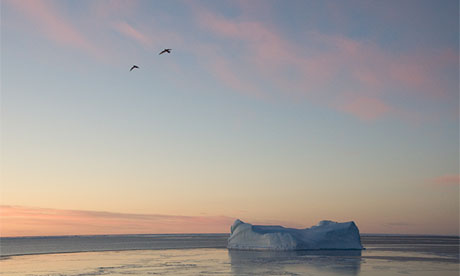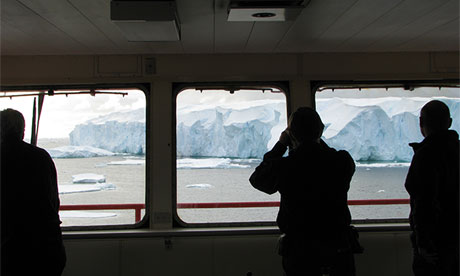
Morning glory: kestrels swoop over an iceberg at Davis Station. Photograph: Australian Antarctic Division/Kristin Raw
I get on the bike and my mind is riding the roads of Union Hall, crossing the narrow wooden bridge, opposite the colourful fishing fleet, turning right towards the harbour where the two islands of Adam and Eve guard the entrance. But I am well outside the safety of Glandore Harbour in Ireland, instead on the Southern Ocean at 60 degrees latitude, sailing on a westerly heading.
On the exercise bike there is a strange sensation: it feels easier to ride uphill and conversely harder to go down as the ship pitches and rolls. The clock swings on the wall, still keeping exact time but going back by an hour every couple of days, and the wails and internal screams of the ballast tanks pierce the gym’s walls, sounding like a distressed whale.
The Whiteness of the Whale, a chapter in Moby Dick, is dedicated to the history of that colourless ”colour”. Herman Melville explores its mythology, its science and its meaning. By coincidence I am reading this chapter lying on my bunk – a regular occupation given the equivalent of aeroplane turbulence that marks every minute of the day – when the first officer announces that our first iceberg has been sighted off our starboard bow.
I am not prepared for just how beautiful an iceberg is, emerging from the mist and the indigo – set against a sky that, without the berg, might be regarded as milky-white. Its crystalline structure glows like sunlight breaking through the clouds of a Rembrandt etching, that pure white of light.
That whiteness of the berg, that iridescent purity, that opaque and semi-opaque glass-cathedral-like structure that soars out of its close but common relative to create something purely wondrous. What is pure white? Is it ”that” white light that some say we reach for as we die? How many words might describe white?
Melville has his own definition: “In essence whiteness is not so much a colour as the visible absence of colour; and at the same time the concrete of all colours; is it for these reasons that there is such a dumb blankness, full of meaning, in a wide landscape of snows – a colourless, all colour of atheism from which we shrink?”

Icebergs seen from the bridge of Aurora Australis. Photograph: Nisha Harris/Australian Antarctic Division
On the bridge of the Aurora ice also has a plethora of technical names: icebergs, of course, but also growler ice (for the noise it makes), brash ice, floebergs, floebits, shuga, grey-white, frazil and many more. My favourite is bergy bits – so technical!
I have prepared my canvas in a studio on board. It is a lab really, usually reserved for scientists and their experiments while sailing south. I often lay an under-colour, usually something warm such as a red or orange, much as Goya did. It is a traditional technique to rid oneself of the whiteness of the canvas.
The paint I am using is a tube that reads Australian Red Gold, which is unimportant except the iceberg was spotted on a longitude of 129 degrees and 39 minutes, which puts our ship directly between Antarctica and the Nullabor Plain. Between the red-gold desert and the white continent at 60 degrees south, where circumpolar currents navigate their way around the great white continent. Between the desert and the greatest reservoir of fresh water on Earth, between my red-gold oil and the white landscape.
The bergs are sparse, rogue, isolated and temporary; they calve as we look at them. The ship is travelling too fast to paint them, ploughing head-on through the waves, creating explosions of white spray that crash over the forward cargo deck and throw my body forward and then back. A quick sketch as the berg retreats off the stern and I descend to the bowels of the ship, to F deck. Down to where the bike is – closer to where the ship’s intestines seem to whistle and belch as it pitches and rolls.
In my bunk my thoughts turn to home, to Union Hall, where some months ago a trawler was lost at the mouth of our usually safe haven; five men lost. A wild and stormy night to be sure, but Irish fishermen see plenty of those. But to be lost so close to home, to run aground on an island named Adam, when the comfort of Eve was so close, makes one acutely aware of the dangers of being on a ship as icebergs the size of these islands pass by.
YOUR COMMENT